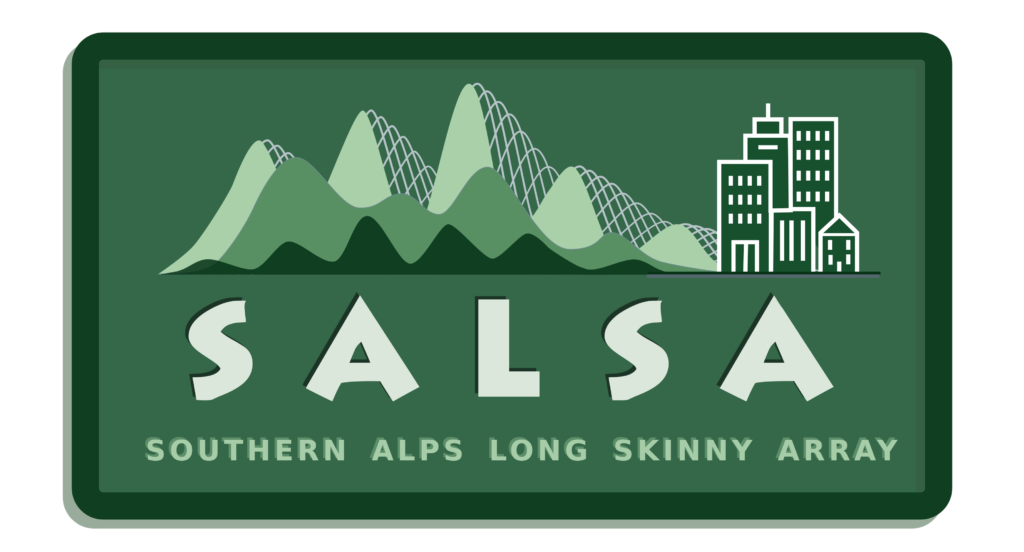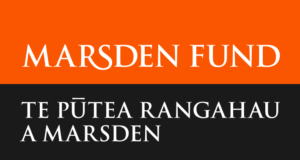

Why SALSA?
There’s a 75% likelihood of the next Alpine Fault earthquake to happen in the next 50 years (Howarth et al., 2021). What will the ground shaking be like?
Ground shaking at a particular location is controlled by the distance of that location to the fault and by:
1- how the fault behaves during the earthquake
2- the geology between the fault and that location
1- How will the fault behave?
Because there is little time before the next earthquake, scientists believe the fault’s current behavior will shape its behavior during the future earthquake.
The current behavior is expressed through various types of very small earthquakes or even the absence of earthquakes along the fault (Warren-Smith et al., 2022).
Recording the seismic activity in time, in detail and all along the fault requires a very dense network of seismometers.
2- How is geology controlling shaking intensity?
Geology can increase/decrease shaking intensity but also fasten/slow down seismic waves.
Seismologists typically use mathematical interpretations of the geology to best simulate expected ground shaking (AF8.org.nz).
However new methods allow us to directly capture these effects by listening to the Earth’s hum! (Denolle et al.)
Our 53 SALSA seismic stations distributed every 10 km along the Alpine Fault, listening to the fault’s “seismic hum”.
Example of a GeoNet station in Christchurch (large green dot) listening to the Earth’s hum between Christchurch and SALSA sites along the fault.
The SALSA project (Southern Alps Long Skinny Array) is funded by the New Zealand Marsden fund (2021-2024). In 2021 the team deployed 53 seismic stations along the Alpine fault to monitor the fault’s current seismic hum and the Earth’s hum between the fault and key NZ locations for 18 months.
SALSA TEAM:
Dr Caroline Holden (SeismoCity and THW-VUW)
Prof John Townend & Dr Calum Chamberlain (THW-VUW)
Carmen Juarez-Garfias & Olivia Pita-Sllim PhD students (THW-VUW)
Dr Emily Warren-Smith (GNS) & Associate Prof. Kasper Van Wijk (UoA)
Assistant professor Marine Denolle (University of Washington)
Prof Hiroe Miyake (University of Tokyo)
Prof Andrew Curtis (University of Edinburgh)
WANT TO FIND OUT MORE?
Check out our facebook page
Check out Julian Thompson’s website including SALSA videos:
Listening to the fault’s whispers
MEDIA RELEASES
2023
https://www.rnz.co.nz/news/national/491430/alpine-fault-s-potential-dangers-are-real-but-still-unknown
https://www.rnz.co.nz/news/national/490651/fibre-cables-offer-scientists-unprecedented-proximity-to-alpine-fault-seismic-zone
https://www.1news.co.nz/2023/05/20/how-west-coast-internet-cables-are-shaking-up-earthquake-research/
2022
https://www.rnz.co.nz/national/programmes/ourchangingworld/audio/2018822479/listening-to-the-hum-of-the-alpine-fault
https://www.nzherald.co.nz/nz/alpine-fault-what-scientists-are-learning-about-nzs-big-quake-maker/Y74677ZF57TIKVFUN4SOAP75LM/
Also check out AF8.org.nz for resources on scientific modelling, coordinated response planning, and community engagement, designed to build resilience to the next Alpine Fault earthquake.
OUTREACH AND PRESENTATIONS
2023 Seismological Society of America Annual Meeting
Pita-Sllim et al., Implementation and Testing of EQTransformer to Detect Microseismicity Near the Alpine Fault, South Island, New Zealand.
Townend et al., Virtual Earthquake Analysis of Future Alpine Fault Earthquakes and GroundShaking Using the Southern Alps Long Skinny Array (SALSA).
Juarez-Garfias et al., Ambient Seismic Noise Studies of the Alpine Fault, New Zealand.
Lozos et al., Dynamic Rupture Simulations on the Alpine Fault: Investigating the Role of Fault Geometry on Rupture Size and Behavior.
Science presentation of the SALSA project as part of the 2023 AF8 roadshow – Holden presented the Marsden work and as part of the AF8 roadshow for the South Island West Coast communities.
11th ACES (APEC Cooperation for Earthquake Science) International Workshop
Holden et al., High-frequency Ground-shaking Simulations for Alpine Fault Earthquake Scenarios.
Warren-Smith et al., Heterogeneity in Microseismicity and Stress Near Rupture-Limiting Section Boundaries Along the Late-Interseismic Alpine Fault.
Juarez-Garfias et al., Mapping Stress Drop Variability Along the Alpine Fault.
Townend et al. Alpine Fault Seismogenesis and its Implications for Rupture Modelling and Ground-Shaking.
2022 Geoscience Society of New Zealand Annual conference
Townend J et al. – The Southern Alps Long Skinny Array (SALSA): Virtual Earthquake Analysis of Future Alpine Fault Earthquakes and Ground Shaking.
Warren-Smith E et al. – Using Microearthquakes to Probe the Structure and Mechanics of Alpine Fault Segment Boundaries and Quantify Implications for Future Rupture.
Holden C et al. – High-frequency Ground-shaking Simulations for Alpine Fault Earthquake Scenarios.
Juarez-Garfias IdC et al. – Mapping Stress Drop Variations Along the Alpine Fault to Investigate Conditional Rupture Segmentation.

Recent Comments